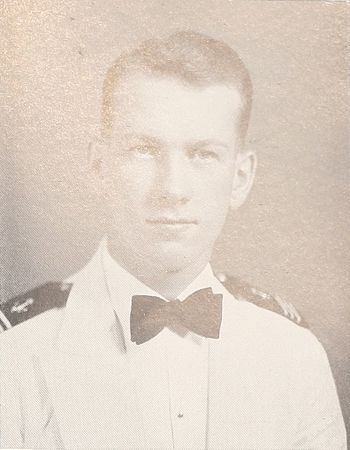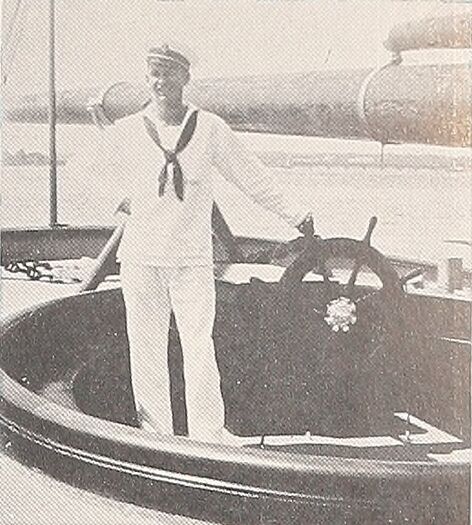ROBERT F. GALLAGHER, LT, USN
Robert Gallagher '42
Lucky Bag
From the 1942 Lucky Bag:
ROBERT FRANCIS GALLAGHER
Canton, New York
Bud, Duke
Anyone who has sense enough not to try to be cheerful before breakfast will make a good roommate, and Bud is no exception. It never took long for the Irish humor to rise though, and then there were laughs aplenty. Aside from a brief flurry with the Bull Department plebe year, he has always known smooth sailing academically. Having sung in the choir and played battalion basketball in the offseason, Bud has had a pleasantly varied academy life.
Battalion Basketball; Glee Club 4; 1 Stripe.
The Class of 1942 graduated on December 19, 1941, less than two weeks after the United States entered World War II. The class had previously been scheduled to graduate in February 1942.

ROBERT FRANCIS GALLAGHER
Canton, New York
Bud, Duke
Anyone who has sense enough not to try to be cheerful before breakfast will make a good roommate, and Bud is no exception. It never took long for the Irish humor to rise though, and then there were laughs aplenty. Aside from a brief flurry with the Bull Department plebe year, he has always known smooth sailing academically. Having sung in the choir and played battalion basketball in the offseason, Bud has had a pleasantly varied academy life.
Battalion Basketball; Glee Club 4; 1 Stripe.
The Class of 1942 graduated on December 19, 1941, less than two weeks after the United States entered World War II. The class had previously been scheduled to graduate in February 1942.
Loss
Robert was lost on March 6, 1945 when the spotting aircraft he was aboard was shot down over Iwo Jima. He was the gunnery officer aboard USS Salt Lake City (CA 25).
Remembrances
From USS Salt Lake City Association:
As the invasion of Iwo Jima continued, the Salt Lake City was one of many ships with big guns used to try to route the Japs from their emplacements and caves.
Our observation planes were also in use and vital. They shared the daily observation duty with other ship's planes and were used to direct the gunfire from many ships and correct the gunner's aim.
Our OS2U was a low wing monoplane with a large float and two cockpits. Also known as a "Kingfisher", the plane had a top speed of 164 mph and a cruising speed of 119 mph. After launching the plane from our catapult the pilot would climb to 3000-4000 feet altitude for observation of shell hits and radio necessary corrections.
On this particular day the observer who was usually an enlisted man riding with the officer pilot had been replaced by a Navy Lieutenant. I suspect this mission was considered a suicide mission calling for volunteers. The Japanese, knowing that Iwo Jima would be invaded, had assembled the best gunners in the Japanese Army for the defense of Iwo Jima.
Ensign Thomas W. Erickson, who was the pilot, agreed to take Lt. Robert F. Gallagher as his observer. Gallagher had washed out of flight school but the lure of being airborne was strong.
The OS2U was catapulted from the ship and climbed to the altitude required for observation. It wasn't long before the Jap anti-aircraft batteries on Iwo Jima began firing at the plane. The plane was hit and spun down into the China Sea killing both men. Due to a quirk of fate, Lt. Robert F. Gallagher now became a casualty. Robert J. Serazin, Lt. (jg)
My father, Robert M. Epperson, flew with Ensign Erickson as his aircrewman. He told us about his death many times. Apparently he was killed when a non-flying artillery officer, Lieut. Robert F. Gallagher, the ship's fire control officer, (officer responsible for directing the fire of the main batteries of guns), kept arguing with our spots. Saying we were flying to high and weren't spotting right." My Dad (Epperson) said the other fire control people thought their spots were "right on". He said he thinks he was using that as an excuse to get a ride over the island. Since he outranked Erickson, he wanted him to know he was "in charge". Rather bossy.
Apparently, as a matter of course, they left the bottom of the parachute harness unbuckled until they were airborne. That made it easier to get out of the parachute if they crashed on take off. Gallagher didn't much care to have my Dad explain how to hook up the straps and how to re-set the radio that always got bumped around from the catapult. "He was a know it all."
They watched the plane take off to the North and then turn left toward the island. "They stayed real close to the water right in over the beach and staying so low it didn't take long for the 'japs' to get them.
Then when Gallagher opened his parachute he fell right out the bottom of it."
When the marines on the island saw the plane crash land they made a charge up the hill in an attempt to rescue the pilot. However when they got to the plane Ensign Erickson was dead. He had completely clawed through the outside of his "May West" and flight suit trying to pull his parachute cord even though he was too far into shock to know that he was still in the plane. Apparently the shell had exploded in his lap and the loss of blood from the wounds caused his death.
Even though that had happened he had kept the plane flying long enough to allow the passenger time to jump free. If that fellow had paid attention to my Dad when he tried to help him with the parachute harness, he may have survived. "J" Epperson, 2001
Other Information
His parents were listed as next of kin.
Robert has a memory marker in New York.
Photographs
Silver Star
The USS Salt Lake City Association lists Robert as a recipient of the Silver Star; unable to find a citation.

The "category" links below lead to lists of related Honorees; use them to explore further the service and sacrifice of alumni in Memorial Hall.
